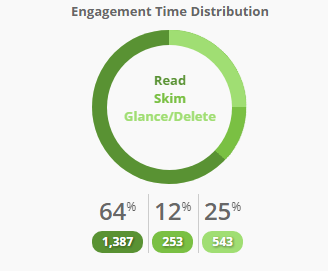Email Marketing
Why Email Engagement and Accessibility Go Hand-in-Hand

Email Marketing

There are certain metrics that will always be important to email marketers. Our recent study, Success in the Inbox: Keys to Effective Email Marketing, revealed that 63% of marketers want email to increase revenue while 50% want it to generate more leads.
That’s not so surprising. What was interesting is that the third most-cited priority for top-tier marketers is “improving email engagement” at 41%. But what does engagement really mean? How do you improve it, and how does designing and developing accessible emails make a difference?

However, the results of Pathwire’s Accessibility in the Inbox survey show that while many marketers believe they’re building accessible campaigns, there’s much more work to be done.
While I can’t speak for all marketers, what I’ve seen is a wide range in how different organizations approach email accessibility. Time constraints often keep email teams from making it a priority as can a lack of knowledge and awareness of the subject.
At Email on Acid, we believe accessible emails are good for business. They are an essential piece of the puzzle for marketers who want to improve subscriber engagement.
Email engagement metrics go far beyond tracking open and clickthrough rates in your campaigns. To truly understand how people are responding to email, you need to go deeper and analyze how they interact with the content. One way to accomplish this is to examine read, skim, and delete/glance metrics.
It’s as simple as it sounds, but it’s also an insightful way to measure engagement. Read, skim, delete stats show you how much time subscribers are spending in your emails. Many email tools, including our platform’s Email Analytics, allow you to set specific thresholds for these engagement metrics.

Heat maps and click maps are also effective ways to analyze subscriber engagement. If you send longer emails or newsletters packed with content, heat maps show you how far down a subscriber gets. Click maps tell you where most people interact with clickable elements in your campaigns.
Marketers use email engagement metrics to improve design, usability, and overall user experience (UX). However, if you’re not optimizing for accessible emails, you’re making it difficult for a significant portion of your audience to engage with what you send them.
Put simply, the more people you want to reach the more accessible your emails need to be. It just makes sense. If groups of people can’t read your emails, they’ll delete them. If people can’t click on your calls-to-action, your metrics and customer engagement potential will take a nosedive.
Consider the fact that, according to the Centers for Disease Control (CDC), 26% of adults in the United States (more than 1 in 4) are living with a disability. That’s 61-million people. The CDC also says 4.6% of U.S. adults have a vision-related disability. Around 8% of males suffer from color blindness, and 12 million Americans over the age of 40 have vision impairments. Globally, the World Health Organization (WHO) estimates at least 1 billion people have an unaddressed vision impairment.
Email marketers who want to improve engagement must consider things such as the readability of the typefaces they use, font size, accessible color choices, and appropriate contrast with every campaign they create. Dark mode emails and accessibility represent another issue that needs to be addressed.
Emails should be coded in a way that works with screen readers so that your messages make sense. Using semantic HTML code (such as <p> and <h> tags) helps screen readers understand your content. If you’ve got an international audience, or are marketing to people who speak different languages, the language attribute (lang=” “) lets screen readers know what to expect.

Even people without vision problems are using screen readers. They’re letting Google Assistant, Siri, and Alexa read their emails in the morning as they walk the dog, feed the kids, hit the treadmill, or multi-task their way through the day.
It pays to develop accessible emails. If your audience can’t listen, see, or grasp the intention of your email, then you are going to lose people. And it’s always harder to get people back who have unsubscribed. Check out some best practices for email accessibility to learn more.
Accessibility isn’t a project it’s a process. First, you need a complete understanding of your audience and how accessibility is likely to affect them. You should also be educating your team on the importance of accessible emails.
When it comes time to optimize emails, start small by implementing a basic checklist into your current process. Use clear and descriptive subject lines, code your emails appropriately for screen readers with headers and tables. Focus on text alignment, color contrast, alt tags on images, descriptive links, and so on. Small things can make a big difference. Then, you can build on that process and watch email engagement numbers grow!
The biggest benefit of accessible emails is how it makes customers and prospects feel about your brand. Instead of feeling frustrated with the UX, it shows that you actually care about their experience. Placing importance on accessibility means you are placing importance on empathy for a wider audience. That ultimately impacts metrics and the bottom line while sending an important message about how your brand approaches inclusivity.
Test everything (including your templates and automations) multiple times to make sure you’re hitting your mark with screen readers, in dark mode, and with images on and off. Then, try taking it a step further. Get some real-life information by watching people with vision impairments read and interact with your emails.
Think about all the work that goes into launching an email campaign. The planning and strategy. The content creation, design, and development. The email pre-deployment testing, split testing, and measurement. That’s a lot of time and resources. In comparison, optimizing for accessibility is a small effort that goes a long way towards better email engagement.
Email on Acid makes testing for accessibility easy! Our Campaign Precheck pre-deployment checklist includes an Accessibility Tool that scans HTML and design elements and makes automatic updates. It also validates your emails against accessibility guidelines. This allows you to make adjustments with a few clicks to ensure ADA compliance with every email.